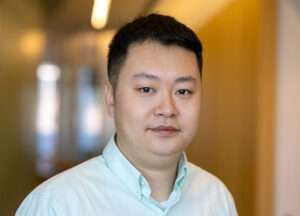Posted on March 13, 2024 in ASRC News, Photonics Initiative

Guo will use the award to help train the next generation of semiconductor researchers.
Qiushi Guo, a professor with the CUNY ASRC’s Photonics Initiative and the CUNY Graduate Center’s Physics program, has received a National Science Foundation (NSF) CAREER Award to support his work developing a femtosecond mode-locked lasers made from lithium niobate—a synthetic salt with strong optical nonlinearity and electro-optic properties.
Mode-locked lasers play a crucial role in measuring natural phenomena occurring at timescales as short as a femtosecond, which is a few quadrillionths of a second. The current technology is restricted to use in laboratory settings, however.
“Conventional laser technology is bulky and expensive, and because of this their applications are also limited,” said Guo. “But with smaller, faster lasers, we can do things we’ve never imagined before.”
To that end, Guo aims to revolutionize ultrafast photonics by transforming mode-lock systems into compact, cost-effective chips that can be deployed outside the lab. His recent study, published in Science, introduces thin-film lithium niobate (TFLN) as a solution to this challenge. By integrating TFLN into mode-locked lasers, Guo and his team have successfully created a laser that is half the size of a dime and capable of producing pulses as short as 5 picoseconds.
And Guo says this is just the beginning. Looking ahead, he plans to develop even smaller, faster, more versatile lasers. His goal is to generate pulses as short as a hundred femtosecond, rivaling the performance of lab tabletop setups. Ultimately, Guo envisions seamlessly combining these compact mode-locked lasers with other lithium niobate nanophotonic components to develop compact ultrafast photonic systems such as atomic clocks, which could revolutionize metrology and information processing.
The CAREER program is NSF’s most prestigious award for junior faculty. Notably, Guo received this recognition in the first year of his assistant professorship, marking a remarkable achievement in his early career.
Interwoven with Guo’s research goals is an education plan aimed at helping to train the next-generation semiconductor workforce. He intends to establish his lab as a “hub” for semiconductor and integrated photonics learning, student mentoring and public outreach. Moreover, Guo plans to establish a new program to connect with underrepresented minorities from local high schools and involve them in advanced semiconductor and photonics research at the CUNY ASRC.
If successful, Guo’s research will represent a significant step forward in the field of ultrafast photonics. His work not only addresses existing challenges but also opens new possibilities for compact and highly efficient laser technologies with diverse applications in the fields of biology, chemistry, and physics.
